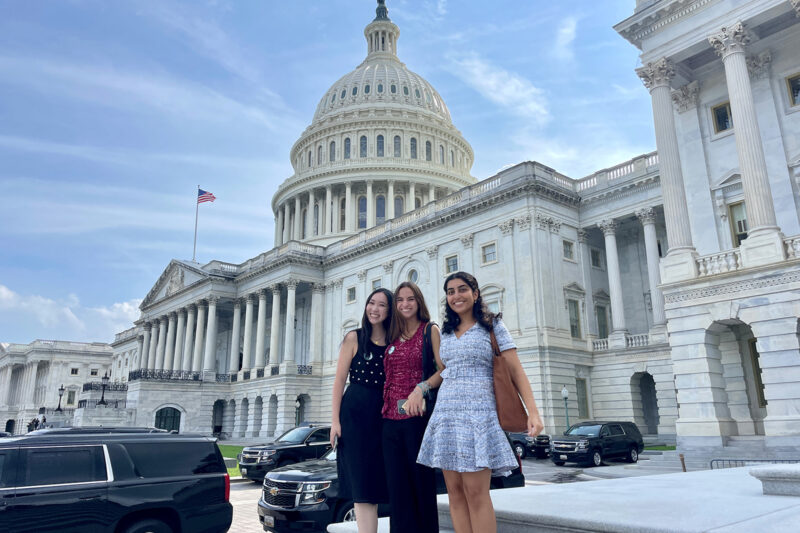Cynthia Sutanto ’24 spent this summer in Washington, D.C. researching community organizing strategies that engage men and boys in gender equality efforts. She engaged with advocates who are modeling healthy masculinity, creating space for open dialogue, and centering joy and community.
Around the world, advances in gender equality have reached a standstill. During the COVID-19 pandemic, stay-at-home orders drastically increased incidents of intimate partner violence. The overturning of Roe v. Wade has emboldened anti-abortion activists both domestically and globally. Whether one looks to the nation’s highest courts or personal family relations, one finds the perpetuation of gender inequality. This is, in part, due to patriarchal constructions of masculinity: cultural attitudes and practices associated with being a man often involve male domination over women.
Yet these attitudes are not unshakeable. In the last three decades, some feminists have shifted their attention to the role of men in building gender equality. Anti-violence organizations such as White Ribbons Campaign and Men Can Stop Rape aim to prevent sexual violence through community-based programs. Other groups focus on developing healthier masculinities for young boys. But while such initiatives have grown rapidly, they are still vastly understudied in the broader realm of feminist scholarship.
This summer, I aimed to fill this research gap by studying the various advocacy strategies used to engage men and boys in gender equality. With the support of the Brady-Johnson Program in Grand Strategy, I traveled to Washington, D.C., to speak with seven advocates who work directly with men and boys in their communities. These advocates represented a wide range of non-profit organizations that promote gender justice: HeForShe, Equimundo, Becky’s Fund, Next Gen Men, and Boys To Men. In our conversations, we discussed the formation of male-centered feminist organizations and effective coalition-building strategies. While each organizer took a slightly different approach to their work, I isolated three common strategies in my research: modeling healthy masculinity, creating space for open dialogue, and centering joy and community.
Each organizer began by discussing their personal stake in the healthy masculinity project. Tayamni Goodshield, a program manager at Boys To Men, talked about how his earliest experiences with men were characterized by violence. Goodshield emphasized the importance of positive male role models, as they were crucial in setting him on a “path to healing.” To Goodshield, community organizers should model healthy masculinity to the boys that they are attempting to engage with. This can include being vulnerable about emotions, sharing personal experiences, and using non-sexist language.
Even for organizers who are not masculine-identifying, presenting healthy male role models in workshops and community events is critical. According to Madelyn Amos, a former organizer with Becky’s Fund, boys were most receptive to nonviolent communication education if their role models exemplified “healthy manhood.” Amos frequently referred to sports stars such as LeBron James in her programming to demonstrate positive masculinity. Regardless of their background, all of the organizers prioritized anti-sexism in their own lives to help others reimagine a healthier version of masculinity.
Additionally, the organizers highlighted the need to hold safe spaces for men and boys to share their feelings. Since many men do not bring their emotional lives into male-dominated spaces, the first step is creating conditions that allow them to express themselves. Albert Reed, a group facilitator for Boys To Men Mentoring Network, said his goal was “not to fix or rescue young boys, but to hold space and listen to them.” Reed encourages boys to think critically about positive relationships on an individual level. To organizers like Reed, cultivating non-confrontational and open spaces is essential to improving men’s emotional health. Despite the challenging topics that organizers cover — mental health and sexual assault, for example — it is important to continually center joy in community work. In addition to hosting discussion circles, Reed takes the boys in his group on surfing trips, hikes, and picnics. During these activities, the boys develop healthy friendships with one another while learning from positive role models. To Reed and others, leisure events show people that practicing healthy masculinity is fulfilling. While committing to anti-sexism requires unlearning oppressive gender norms, the process should also enhance men’s and boys’ lives.
I want to thank Yale professors Audrey Latura and Michael Flood for sparking my interest in building a more gender-diverse feminist movement. While my work is by no means exhaustive, I hope that it can offer general guidance for gender equality activists who seek to engage men and boys in the cause. To reinvigorate feminism, we all must assess our roles in perpetuating gender injustice.
Cynthia Sutanto ’24 is a current student in the Brady-Johnson Grand Strategy Program.
